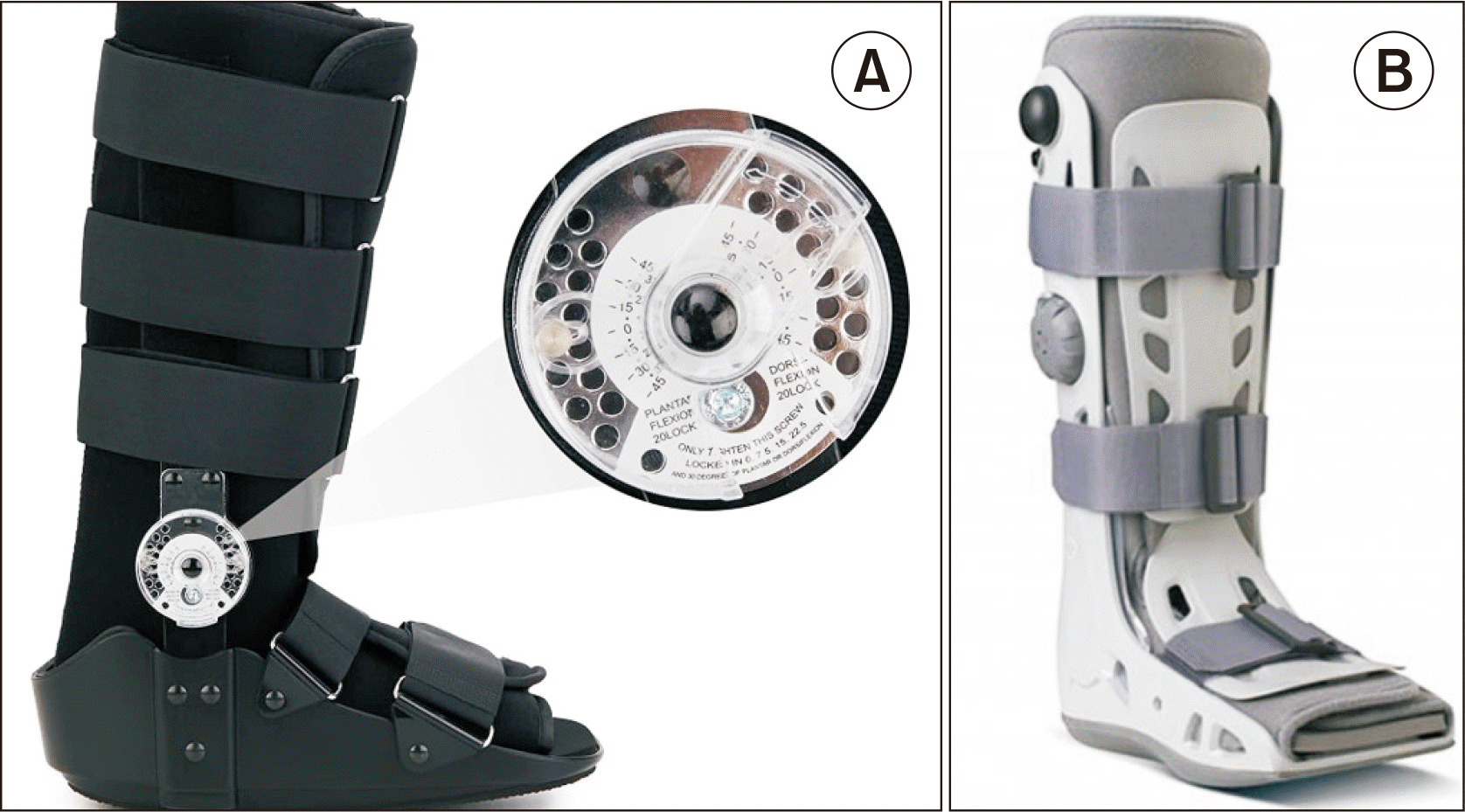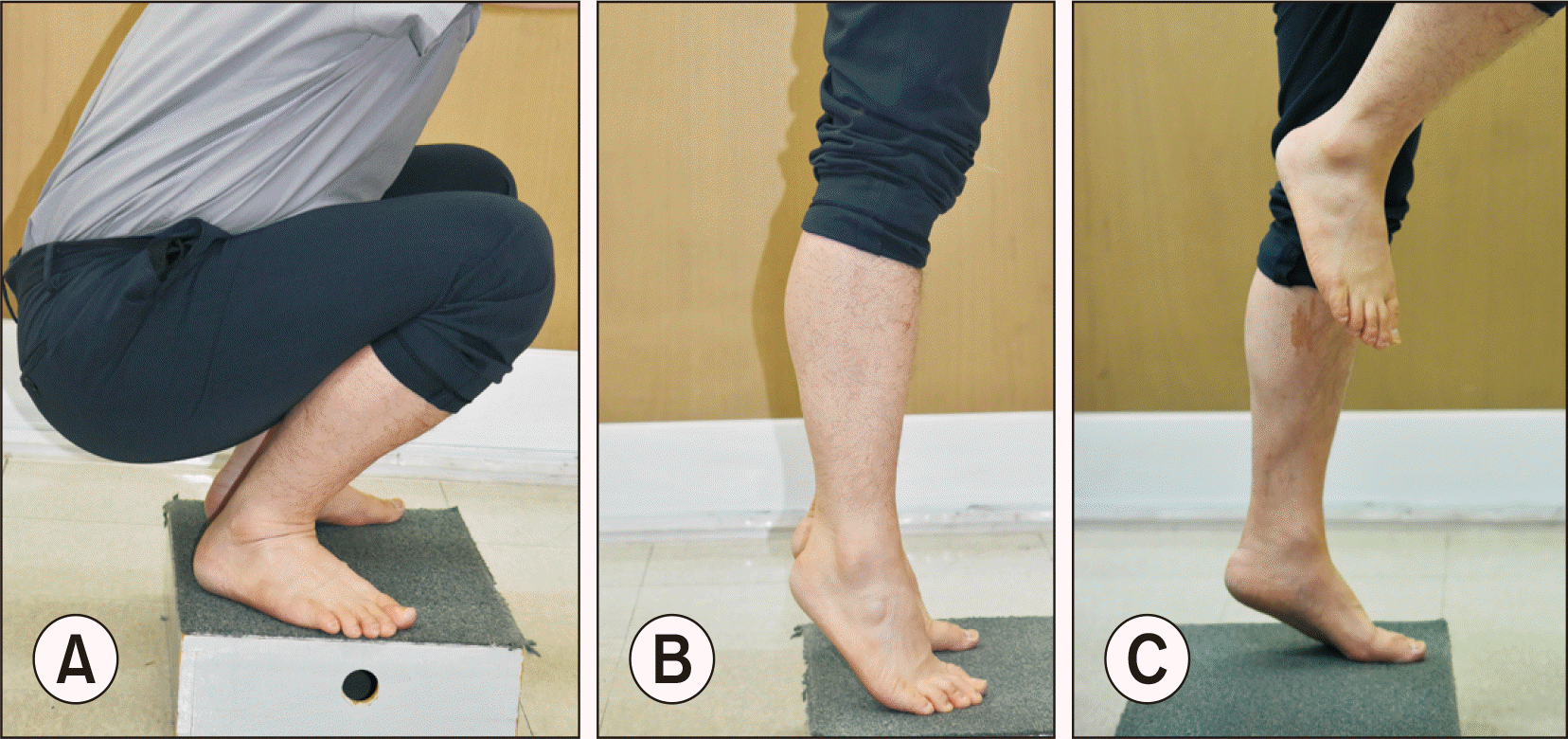1. Suchak AA, Bostick G, Reid D, Blitz S, Jomha N. 2005; The incidence of Achilles tendon ruptures in Edmonton, Canada. Foot Ankle Int. 26:932–6. doi: 10.1177/107110070502601106. DOI:
10.1177/107110070502601106. PMID:
16309606.

2. Maempel JF, Clement ND, Wickramasinghe NR, Duckworth AD, Keating JF. Operative repair of acute Achilles tendon rupture does not give superior patient-reported outcomes to nonoperative management. Bone Joint J. 2020; 102-B:933–40. doi: 10.1302/0301-620X.102B7.BJJ-2019-0783.R3. DOI:
10.1302/0301-620X.102B7.BJJ-2019-0783.R3. PMID:
32600149.

3. Gould HP, Bano JM, Akman JL, Fillar AL. 2021; Postoperative rehabilitation following achilles tendon repair: a systematic review. Sports Med Arthrosc Rev. 29:130–45. doi: 10.1097/JSA.0000000000000309. DOI:
10.1097/JSA.0000000000000309. PMID:
33972490.

4. McCormack R, Bovard J. 2015; Early functional rehabilitation or cast immobilisation for the postoperative management of acute Achilles tendon rupture? A systematic review and meta-analysis of randomised controlled trials. Br J Sports Med. 49:1329–35. doi: 10.1136/bjsports-2015-094935. DOI:
10.1136/bjsports-2015-094935. PMID:
26281836.

5. Frankewycz B, Krutsch W, Weber J, Ernstberger A, Nerlich M, Pfeifer CG. 2017; Rehabilitation of Achilles tendon ruptures: is early functional rehabilitation daily routine? Arch Orthop Trauma Surg. 137:333–40. doi: 10.1007/s00402-017-2627-9. DOI:
10.1007/s00402-017-2627-9. PMID:
28097423.

6. Kim U, Choi YS, Jang GC, Choi YR. 2017; Early rehabilitation after open repair for patients with a rupture of the Achilles tendon. Injury. 48:1710–3. doi: 10.1016/j.injury.2017.04.050. DOI:
10.1016/j.injury.2017.04.050. PMID:
28465006.

7. Okoroha KR, Ussef N, Jildeh TR, Khalil LS, Hasan L, Bench C, et al. 2020; Comparison of tendon lengthening with traditional versus accelerated rehabilitation after Achilles tendon repair: a prospective randomized controlled trial. Am J Sports Med. 48:1720–6. doi: 10.1177/0363546520909389. DOI:
10.1177/0363546520909389. PMID:
32203675.

8. Röell AE, Timmers TK, van der Ven DJC, van Olden GDJ. 2021; Rehabilitation after surgical repair of acute Achilles tendon rupture: functional outcome with a minimum follow-up of 6 months. J Foot Ankle Surg. 60:482–8. doi: 10.1053/j.jfas.2020.09.003. DOI:
10.1053/j.jfas.2020.09.003. PMID:
33546991.

9. Valkering KP, Aufwerber S, Ranuccio F, Lunini E, Edman G, Ackermann PW. 2017; Functional weight-bearing mobilization after Achilles tendon rupture enhances early healing response: a single-blinded randomized controlled trial. Knee Surg Sports Traumatol Arthrosc. 25:1807–16. doi: 10.1007/s00167-016-4270-3. DOI:
10.1007/s00167-016-4270-3. PMID:
27539402. PMCID:
PMC5487693.

10. Won Lee K, Bae JY, Ho BC, Kim JH, Seo DK. 2022; Immediate weightbearing and ankle motion exercise after acute Achilles tendon rupture repair. J Foot Ankle Surg. 61:604–8. doi: 10.1053/j.jfas.2021.10.021. DOI:
10.1053/j.jfas.2021.10.021. PMID:
34785129.

11. Soroceanu A, Sidhwa F, Aarabi S, Kaufman A, Glazebrook M. 2012; Surgical versus nonsurgical treatment of acute Achilles tendon rupture: a meta-analysis of randomized trials. J Bone Joint Surg Am. 94:2136–43. doi: 10.2106/JBJS.K.00917. DOI:
10.2106/JBJS.K.00917. PMID:
23224384. PMCID:
PMC3509775.
12. Movin T, Ryberg A, McBride DJ, Maffulli N. 2005; Acute rupture of the Achilles tendon. Foot Ankle Clin. 10:331–56. doi: 10.1016/j.fcl.2005.01.003. DOI:
10.1016/j.fcl.2005.01.003. PMID:
15922923.

13. Longo UG, Rittweger J, Garau G, Radonic B, Gutwasser C, Gilliver SF, et al. 2009; No influence of age, gender, weight, height, and impact profile in achilles tendinopathy in masters track and field athletes. Am J Sports Med. 37:1400–5. doi: 10.1177/0363546509332250. DOI:
10.1177/0363546509332250. PMID:
19329789.

14. Notarnicola A, Maccagnano G, Di Leo M, Tafuri S, Moretti B. 2014; Overload and neovascularization of Achilles tendons in young artistic and rhythmic gymnasts compared with controls: an observational study. Musculoskelet Surg. 98:115–20. doi: 10.1007/s12306-013-0275-y. DOI:
10.1007/s12306-013-0275-y. PMID:
23716192.

15. Inglis AE, Scott WN, Sculco TP, Patterson AH. 1976; Ruptures of the tendo achillis. An objective assessment of surgical and non-surgical treatment. J Bone Joint Surg Am. 58:990–3. DOI:
10.2106/00004623-197658070-00015. PMID:
977631.

16. Jacobs D, Martens M, Van Audekercke R, Mulier JC, Mulier F. 1978; Comparison of conservative and operative treatment of Achilles tendon rupture. Am J Sports Med. 6:107–11. doi: 10.1177/036354657800600302. DOI:
10.1177/036354657800600302. PMID:
655329.

17. Maxwell LC, Enwemeka CS. 1992; Immobilization-induced muscle atrophy is not reversed by lengthening the muscle. Anat Rec. 234:55–61. doi: 10.1002/ar.1092340107. DOI:
10.1002/ar.1092340107. PMID:
1416097.

18. Rantanen J, Hurme T, Kalimo H. 1999; Calf muscle atrophy and Achilles tendon healing following experimental tendon division and surgery in rats. Comparison of postoperative immobilization of the muscle-tendon complex in relaxed and tensioned positions. Scand J Med Sci Sports. 9:57–61. doi: 10.1111/j.1600-0838.1999.tb00208.x. DOI:
10.1111/j.1600-0838.1999.tb00208.x. PMID:
9974199.

19. Liu X, Dai TJ, Li BL, Li C, Zheng ZY, Liu Y. Early functional rehabilitation compared with traditional immobilization for acute Achilles tendon ruptures: a meta-analysis. Bone Joint J. 2021; 103-B:1021–30. doi: 10.1302/0301-620X.103B6.BJJ-2020-1890.R1. DOI:
10.1302/0301-620X.103B6.BJJ-2020-1890.R1. PMID:
34058871.
20. Mosconi M, Pasta G, Annunziata S, Guerrieri V, Ghiara M, Perelli S, et al. 2022; Fast functional rehabilitation protocol versus plaster cast immobilization protocol after Achilles tendon tenorrhaphy: is it different? Clinical, ultrasonographic, and elastographic comparison. Diagnostics (Basel). 12:1824. doi: 10.3390/diagnostics12081824. DOI:
10.3390/diagnostics12081824. PMID:
36010175. PMCID:
PMC9406849.





 PDF
PDF Citation
Citation Print
Print





 XML Download
XML Download